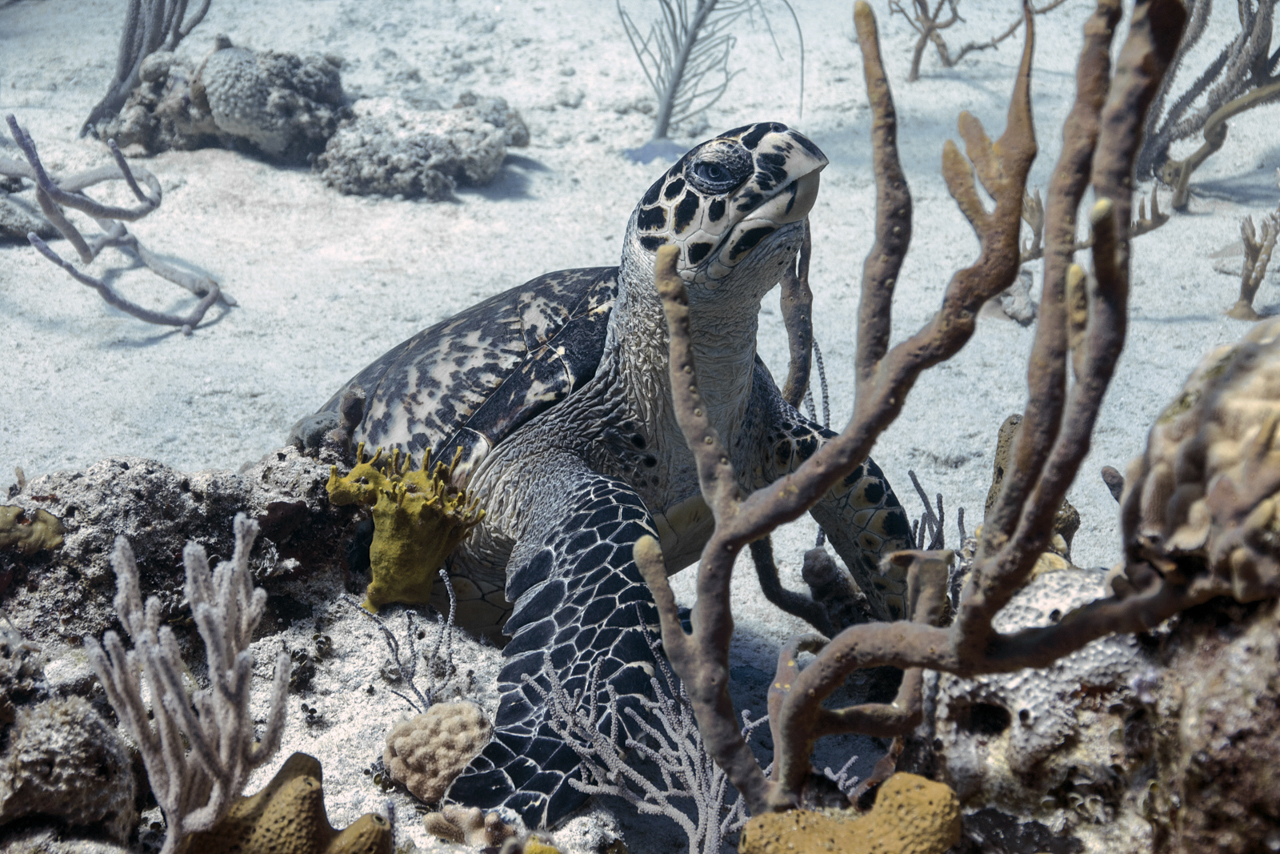
Incredibly friendly and “chilled” Hawksbill Turtle, a bit on the small side.
Highbourne Cay, Bahamas, April 2018
I stayed with her for an hour; she let me closer and closer in. By the end of the dive she was eating 60 centimeters from my leg.
You would not believe how lovely, beautiful and trusting this small turtle was.
I was about to call – quit – a very boring dive with unremarkable coral and precious few fish when, out of the corner of my eye, I saw this small turtle rise to the surface for a breath. I approached and rose with it, not sure how close it would allow me.
Next thing you knew I was with this sweet thing for the whole dive – at least 45 minutes – and until I ran out of air.
As in this image she (I always think of turtles as female and sharks as male!) was against a coral head for a few minutes and it seemed like she was actually playing with me – as if it were a game, with me watching her and her watching me, and she was staying just far away enough, an obstacle between us just big enough, to make shooting her harder!
I love the way she’s resting her flipper on the coral here – and how close it seems compared to her body.
She had a fairly dark shell.
She very clearly trusted my buddy and me, was visibly relaxed, and even started eating just next to us.
It seems very rare for animals, even the more familiar and trusting ones, to snack next to you!
She got in all sorts of dining positions: upside down over her food; diagonal; on the bottom with her head held high…
Another lovely and touching creature I may never forget, photographs I will regularly look at nostalgically and, hopefully, select from for exhibitions and publications.
Highbourne Cay, Bahamas, April 2018
I stayed with her for an hour; she let me closer and closer in. By the end of the dive she was eating 60 centimeters from my leg.
You would not believe how lovely, beautiful and trusting this small turtle was.
I was about to call – quit – a very boring dive with unremarkable coral and precious few fish when, out of the corner of my eye, I saw this small turtle rise to the surface for a breath. I approached and rose with it, not sure how close it would allow me.
Next thing you knew I was with this sweet thing for the whole dive – at least 45 minutes – and until I ran out of air.
As in this image she (I always think of turtles as female and sharks as male!) was against a coral head for a few minutes and it seemed like she was actually playing with me – as if it were a game, with me watching her and her watching me, and she was staying just far away enough, an obstacle between us just big enough, to make shooting her harder!
I love the way she’s resting her flipper on the coral here – and how close it seems compared to her body.
She had a fairly dark shell.
She very clearly trusted my buddy and me, was visibly relaxed, and even started eating just next to us.
It seems very rare for animals, even the more familiar and trusting ones, to snack next to you!
She got in all sorts of dining positions: upside down over her food; diagonal; on the bottom with her head held high…
Another lovely and touching creature I may never forget, photographs I will regularly look at nostalgically and, hopefully, select from for exhibitions and publications.
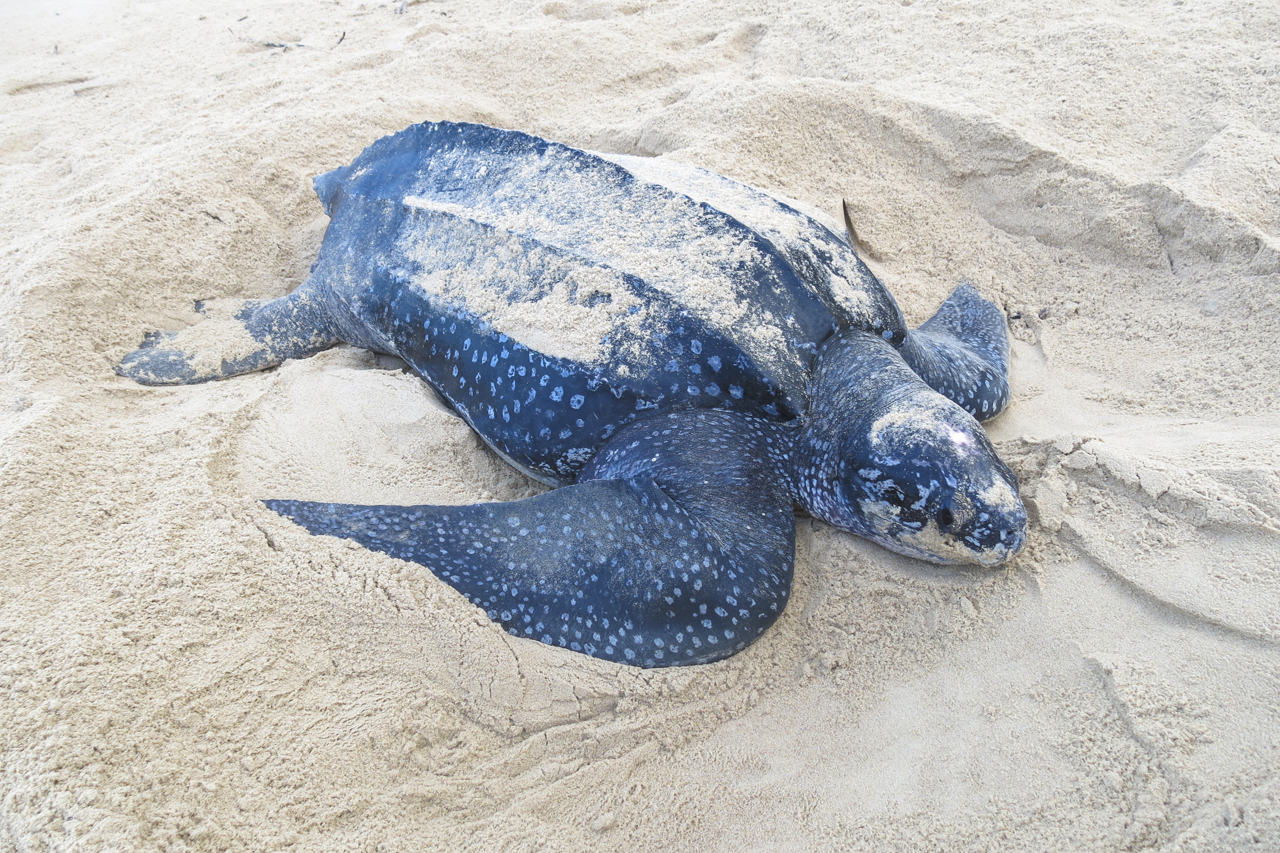
A Leatherback Turtle briefly rests just after sunrise, having laid her eggs in the dark at Pongara Beach in Gabon – one of the most prolific leatherback nesting grounds the world over.
November 2012
Only one hatchling out of a thousand survives to adulthood.
People rarely see leatherbacks in the water…
November 2012
Only one hatchling out of a thousand survives to adulthood.
People rarely see leatherbacks in the water…
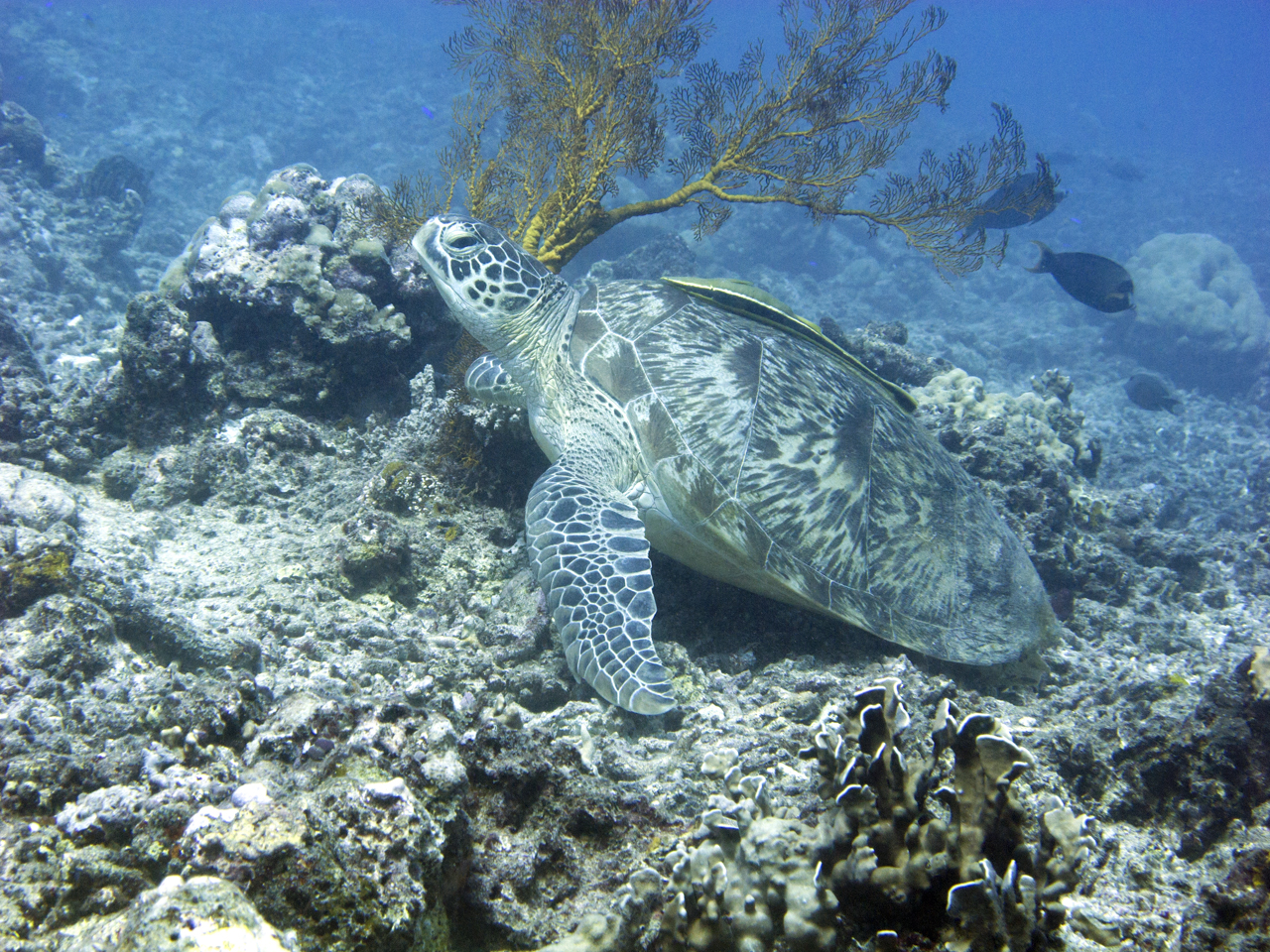
“Turtle with remora”
Gili Trawangan, Indonesia, August 2012
Gili Trawangan, Indonesia, August 2012

Loggerhead love-bite — two Loggerhead Turtles, presumably a mating couple, uniting.
For a brief, unforgettable moment after, I was sandwiched between them.
Danger Reef, The Exumas, April 2014
For a brief, unforgettable moment after, I was sandwiched between them.
Danger Reef, The Exumas, April 2014

Hawksbill Turtle flying at a site near Nassau in the Bahamas, April 2015
I stayed with this one for a while. She was exceptionally elegant and unafraid.
I stayed with this one for a while. She was exceptionally elegant and unafraid.

Green Turtle with a Remora in the seagrass, the turtle’s favorite food.
At Jeep Reef, The Exumas, April 2016
Seagrass comprises a significant amount of a green turtle’s diet…
People who dive this site (Jeep Reef, famous for a sunken and coral-encrusted jeep or 2), myself included, are lucky to see green turtles on a regular basis. And while some will swim away in a panic at the sight of a bubble even 15 meters away, others are very calm and have no qualms with you coming in very close to them.
It all depends on the individual.
You feel like the luckiest person in the world when an animal (and particularly an endangered one) seems to trust you enough to allow you right next to it. And the joy and connections I have felt when swimming with some turtles, dolphins, whales, and one manta ray — sometimes for extended periods of time — are indescribable. The sense of intelligence, impression of trust and, one might say, the happiness one derives from these encounters can be nearly unimaginable.
At Jeep Reef, The Exumas, April 2016
Seagrass comprises a significant amount of a green turtle’s diet…
People who dive this site (Jeep Reef, famous for a sunken and coral-encrusted jeep or 2), myself included, are lucky to see green turtles on a regular basis. And while some will swim away in a panic at the sight of a bubble even 15 meters away, others are very calm and have no qualms with you coming in very close to them.
It all depends on the individual.
You feel like the luckiest person in the world when an animal (and particularly an endangered one) seems to trust you enough to allow you right next to it. And the joy and connections I have felt when swimming with some turtles, dolphins, whales, and one manta ray — sometimes for extended periods of time — are indescribable. The sense of intelligence, impression of trust and, one might say, the happiness one derives from these encounters can be nearly unimaginable.
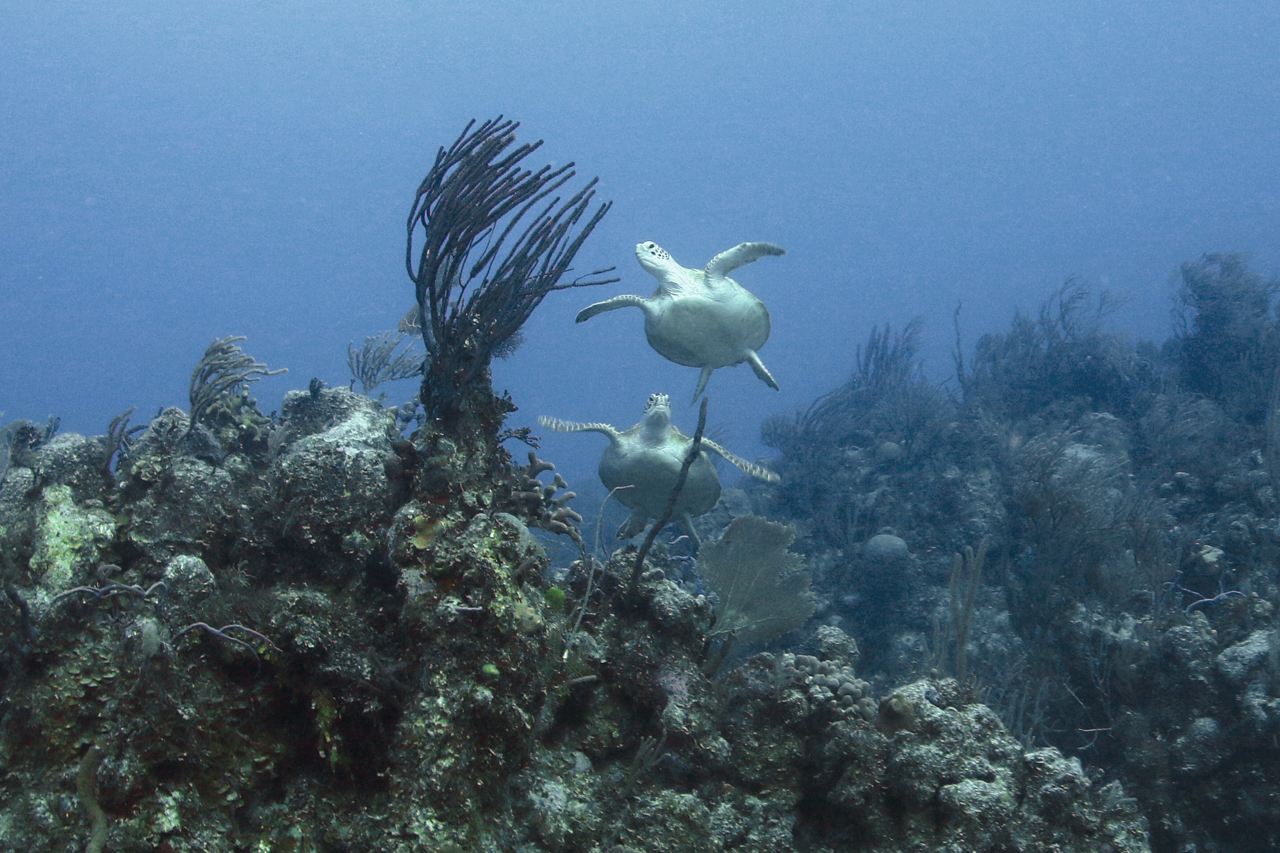
I couldn’t tell whether these were siblings or mates; but they were exactly the same size and color. And beautiful. Unfortunately they quickly swam off once I got close.
Danger Reef in The Bahamas, January 2017
Danger Reef in The Bahamas, January 2017
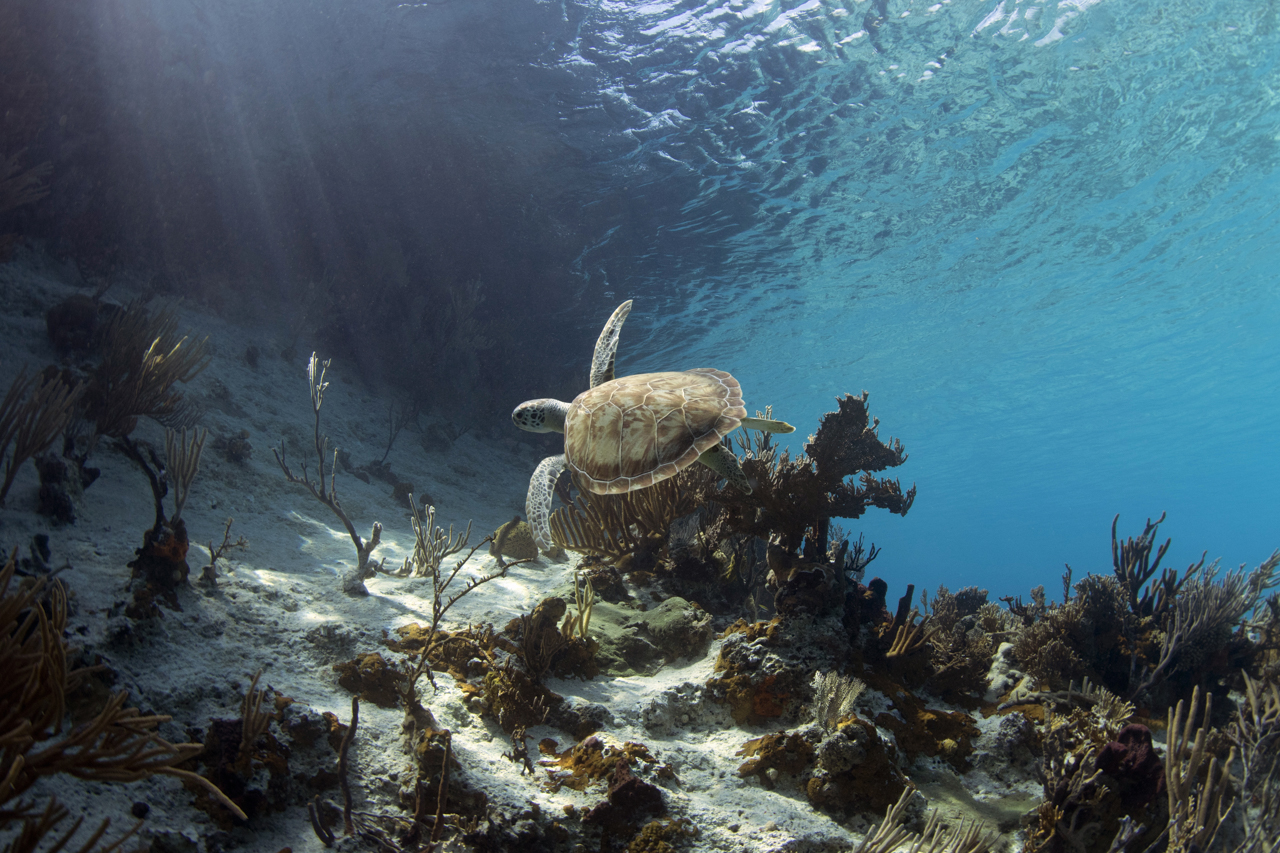
Medium-sized Green Turtle with a beautiful shell I affectionately call “Matilda” in surface light rays at the site called The Aquarium in the Exumas.
April 2017
I visit Matilda 20-25 times a year; we have a good working relationship!
She is a phenomenal model! Not shy at all, on a lucky day she’ll let you swim with her, very close, for half an hour or more. "The Aquarium” is a very shallow site, so your air lasts a long time — more than long enough for a lengthy swim with Matilda or one of her reptilian friends.
Green turtles, like all other turtle species, are endangered. But I believe greens are the most common. Shell color varies greatly among regions and animals. In the Galapagos green turtle shells sometimes seem virtually black, whereas in a few Hawaiian bays there are turtles rumored to have whitish shells. Barnacles and algae sometimes grow on shells, making some look darker and/or dirtier than others…
The green turtles with the nicest shells I see in the Bahamas, such as the one in this photograph, tend to be small or medium size — so presumably on the young side.
April 2017
I visit Matilda 20-25 times a year; we have a good working relationship!
She is a phenomenal model! Not shy at all, on a lucky day she’ll let you swim with her, very close, for half an hour or more. "The Aquarium” is a very shallow site, so your air lasts a long time — more than long enough for a lengthy swim with Matilda or one of her reptilian friends.
Green turtles, like all other turtle species, are endangered. But I believe greens are the most common. Shell color varies greatly among regions and animals. In the Galapagos green turtle shells sometimes seem virtually black, whereas in a few Hawaiian bays there are turtles rumored to have whitish shells. Barnacles and algae sometimes grow on shells, making some look darker and/or dirtier than others…
The green turtles with the nicest shells I see in the Bahamas, such as the one in this photograph, tend to be small or medium size — so presumably on the young side.

A curious Green Turtle comes in close during a feed at Little Farmer’s Cay in the Exumas, April 2017
Up to thirteen green turtles come into the small bay at a time to eat the conch that a couple of feeders prepare every day.
A loggerhead turtle is said to occasionally show up as well.
Some of the turtles at Farmer’s are gigantic.
These turtles are seriously habituated to people… even though they can be skittish and swim off the second they have food in their mouths.
A number of stingrays, remoras and other fish – and a gigantic and adorable porcupinefish – are also in the fray, trying to steal the turtles’ food or get scraps.
We always go at high tide because it’s very shallow there and too easy to kick up sand and ruin photos.
Up to thirteen green turtles come into the small bay at a time to eat the conch that a couple of feeders prepare every day.
A loggerhead turtle is said to occasionally show up as well.
Some of the turtles at Farmer’s are gigantic.
These turtles are seriously habituated to people… even though they can be skittish and swim off the second they have food in their mouths.
A number of stingrays, remoras and other fish – and a gigantic and adorable porcupinefish – are also in the fray, trying to steal the turtles’ food or get scraps.
We always go at high tide because it’s very shallow there and too easy to kick up sand and ruin photos.
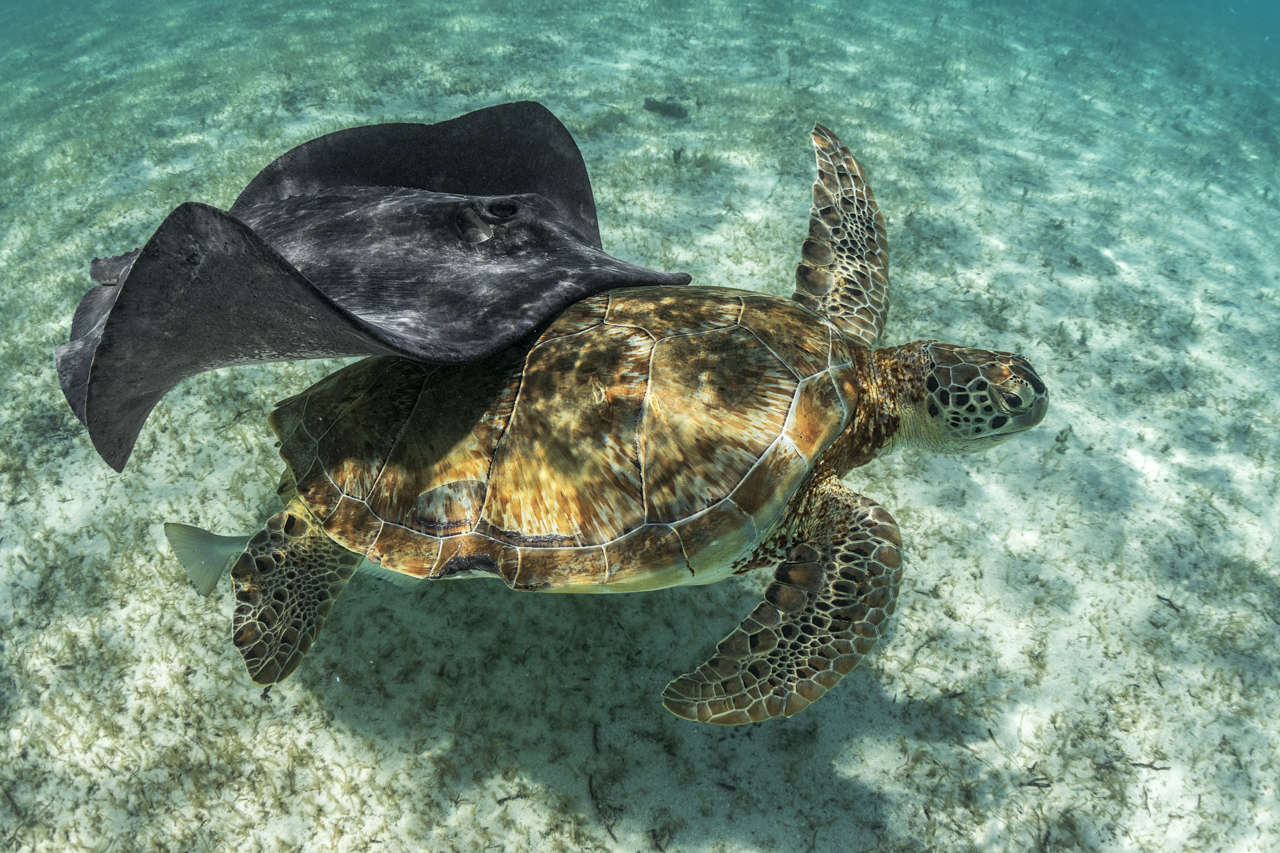
A Stingray rides a Green Turtle during a feeding session at Little Farmer’s Cay in the Bahamas, April 2017
I had never seen this interspecies behaviour before – and have not since.
The other remarkable thing about the situation is that the stingray was missing its tail entirely.
I wonder whether the ray was deriving some sort of nutrition from the algae on the turtle’s carapace, chasing away its competition for food or simply taking a joyride!
I had never seen this interspecies behaviour before – and have not since.
The other remarkable thing about the situation is that the stingray was missing its tail entirely.
I wonder whether the ray was deriving some sort of nutrition from the algae on the turtle’s carapace, chasing away its competition for food or simply taking a joyride!
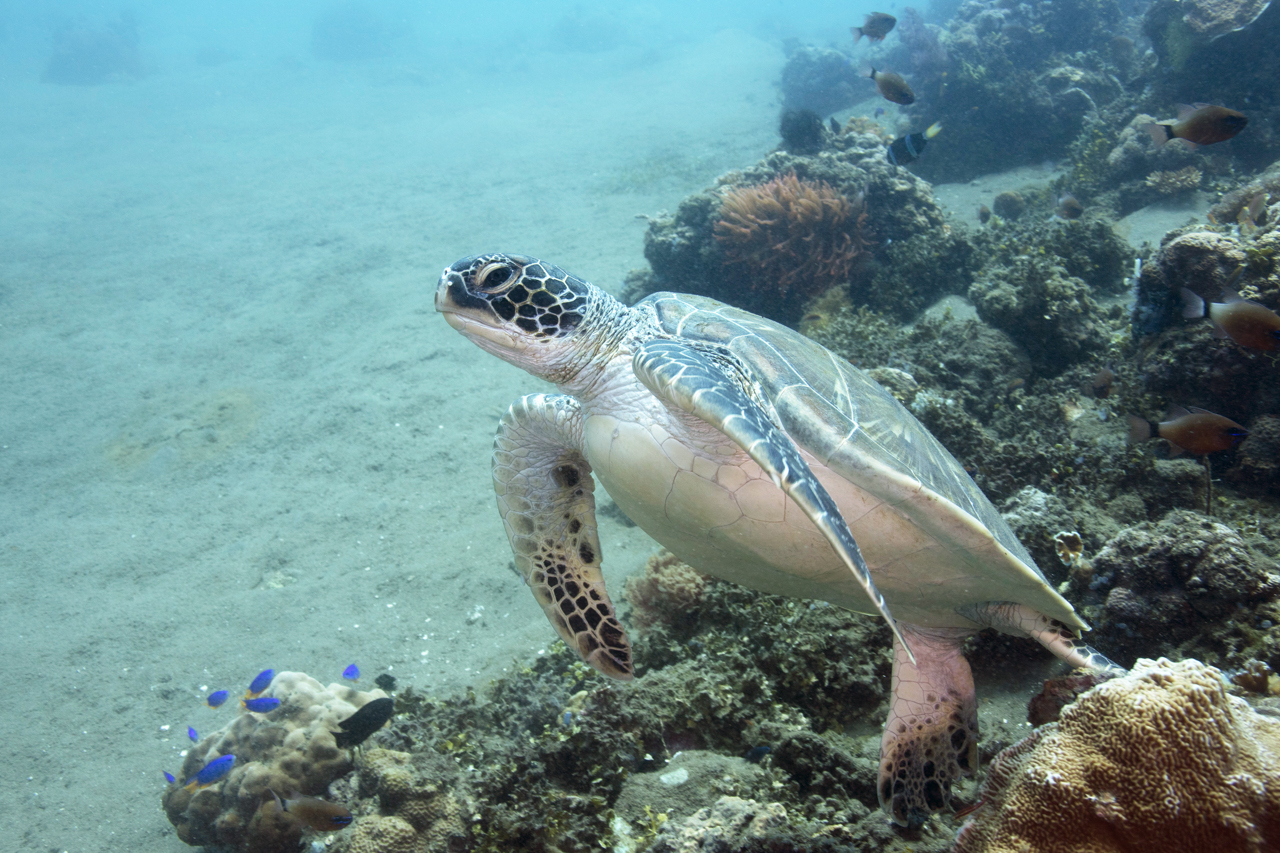
A thoroughly endearing, fragile seeming turtle with the reddest head and face I’ve ever seen.
Philippines, May 2017
I immediately saw this turtle at the beginning of a dive. It was one of the most beautiful I’ve seen. But it was moving very slowly and a bit clumsily – so I wondered whether it wasn’t sick.
My buddies and I spent some time with it and, after a few minutes, it seemed stronger than I’d thought.
It eventually swam off.
Philippines, May 2017
I immediately saw this turtle at the beginning of a dive. It was one of the most beautiful I’ve seen. But it was moving very slowly and a bit clumsily – so I wondered whether it wasn’t sick.
My buddies and I spent some time with it and, after a few minutes, it seemed stronger than I’d thought.
It eventually swam off.
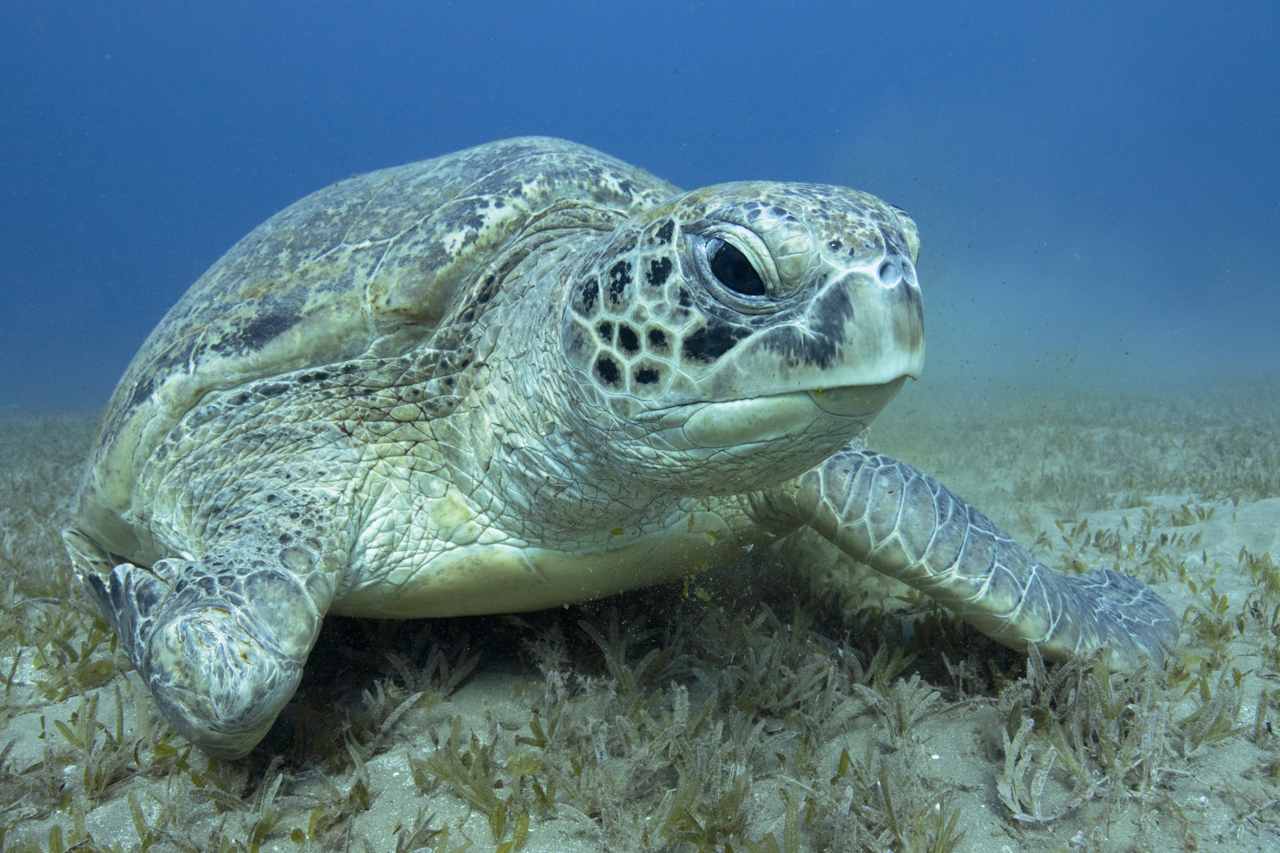
A gigantic turtle at Marsa Mubarak, Egypt, in December 2017.
Not sure I’ve ever seen a bigger or, presumably, older turtle.
It just sat there, eating, imposing, unbothered by my buddy’s and my presence.
Not sure I’ve ever seen a bigger or, presumably, older turtle.
It just sat there, eating, imposing, unbothered by my buddy’s and my presence.
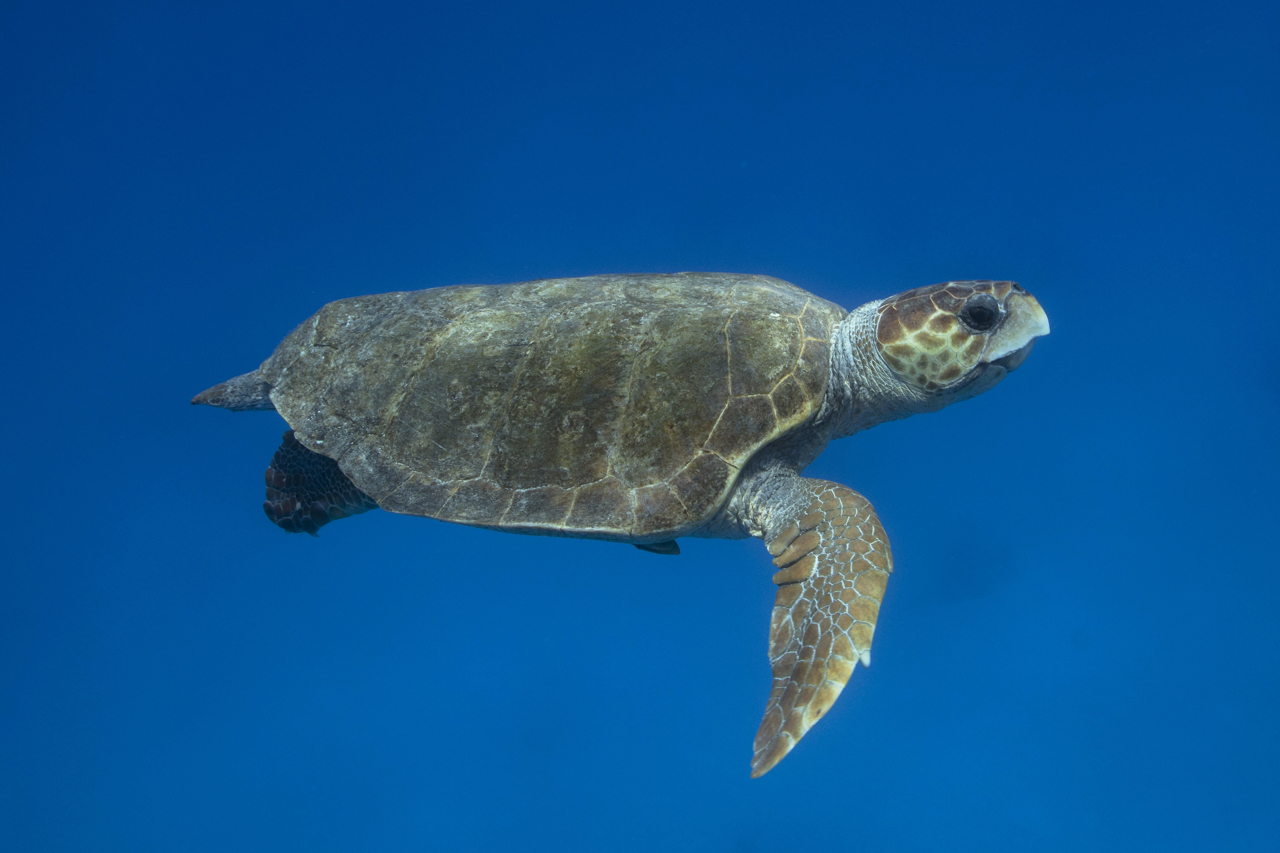
Loggerhead Turtle I followed to the surface after trying to shoot him for what felt like an eternity down below.
Danger Reef, the Bahamas, April 2018
I love this image – and swam far up and down to get it.
The loggerheads I’ve come across have always been remarkably dismissive, neglecting divers entirely in a relentless pursuit of long-distance swimming!
Even when I am next to their faces, not following them from behind, they refuse to look my way. So I get no good portraits, and images like the one above are rare rewards.
Danger Reef, the Bahamas, April 2018
I love this image – and swam far up and down to get it.
The loggerheads I’ve come across have always been remarkably dismissive, neglecting divers entirely in a relentless pursuit of long-distance swimming!
Even when I am next to their faces, not following them from behind, they refuse to look my way. So I get no good portraits, and images like the one above are rare rewards.
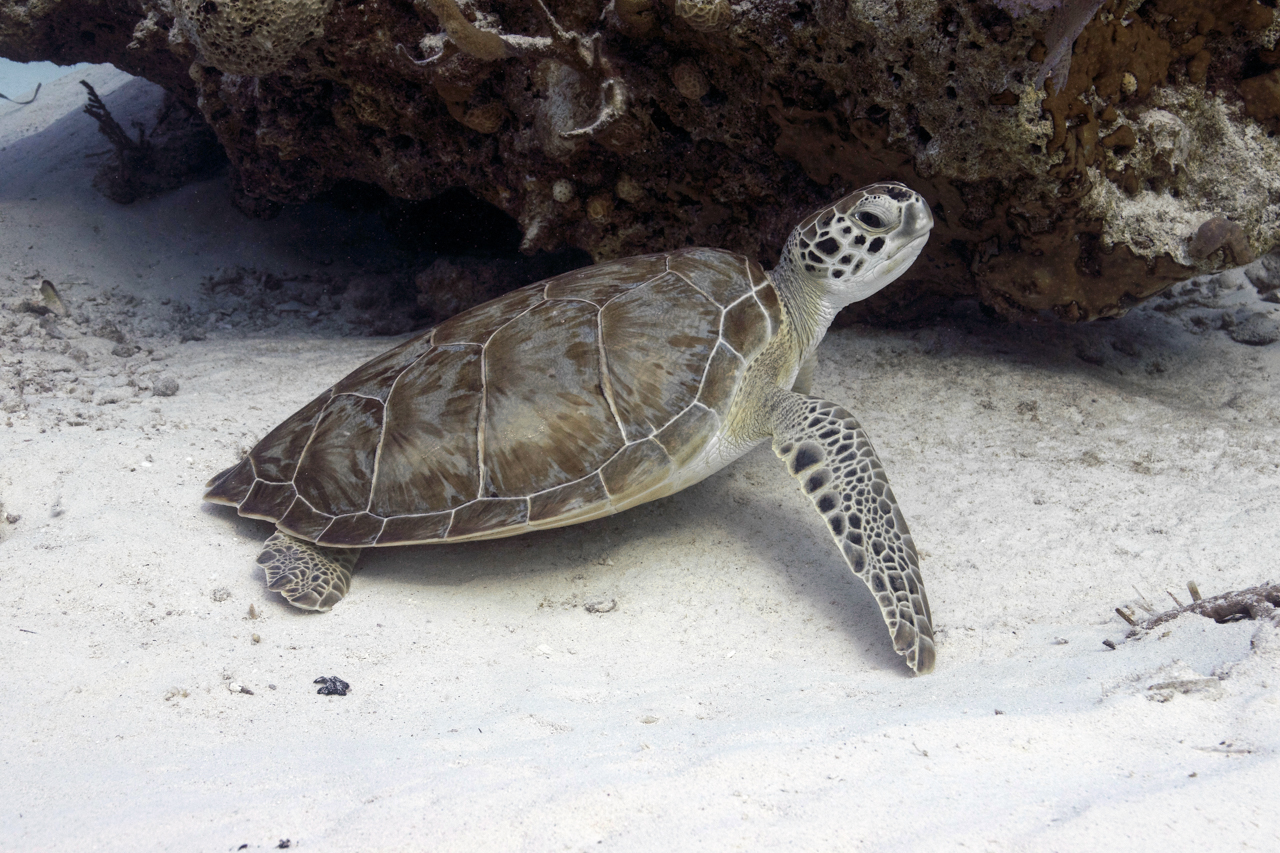
Matilda or Monique – a Green Turtle -- next to her favourite coral head at “The Aquarium”-- a popular snorkelling and diving site
In the Exumas, April 2018
Matilda and Monique, as I’ve affectionately named them after dozens of dives in their small territory and hours by their side, are nearly identical-looking – the same size and nearly the exact same colour carapace. I couldn’t necessarily tell them apart (whereas “Melissa” is much smaller, paler, and has some chinks in her armour). But I know that both are creatures of habit – swimming over the same coral heads, in the same currents and channels and above the same sand patches multiple times a day. They’re both highly tolerant of human company and both have allowed me to photograph and swim with them for up to an hour at a time. It is an immense and rare privilege, and they may well be my most regular models and favourite wild (or “habituated”) animals in the world.
In the Exumas, April 2018
Matilda and Monique, as I’ve affectionately named them after dozens of dives in their small territory and hours by their side, are nearly identical-looking – the same size and nearly the exact same colour carapace. I couldn’t necessarily tell them apart (whereas “Melissa” is much smaller, paler, and has some chinks in her armour). But I know that both are creatures of habit – swimming over the same coral heads, in the same currents and channels and above the same sand patches multiple times a day. They’re both highly tolerant of human company and both have allowed me to photograph and swim with them for up to an hour at a time. It is an immense and rare privilege, and they may well be my most regular models and favourite wild (or “habituated”) animals in the world.
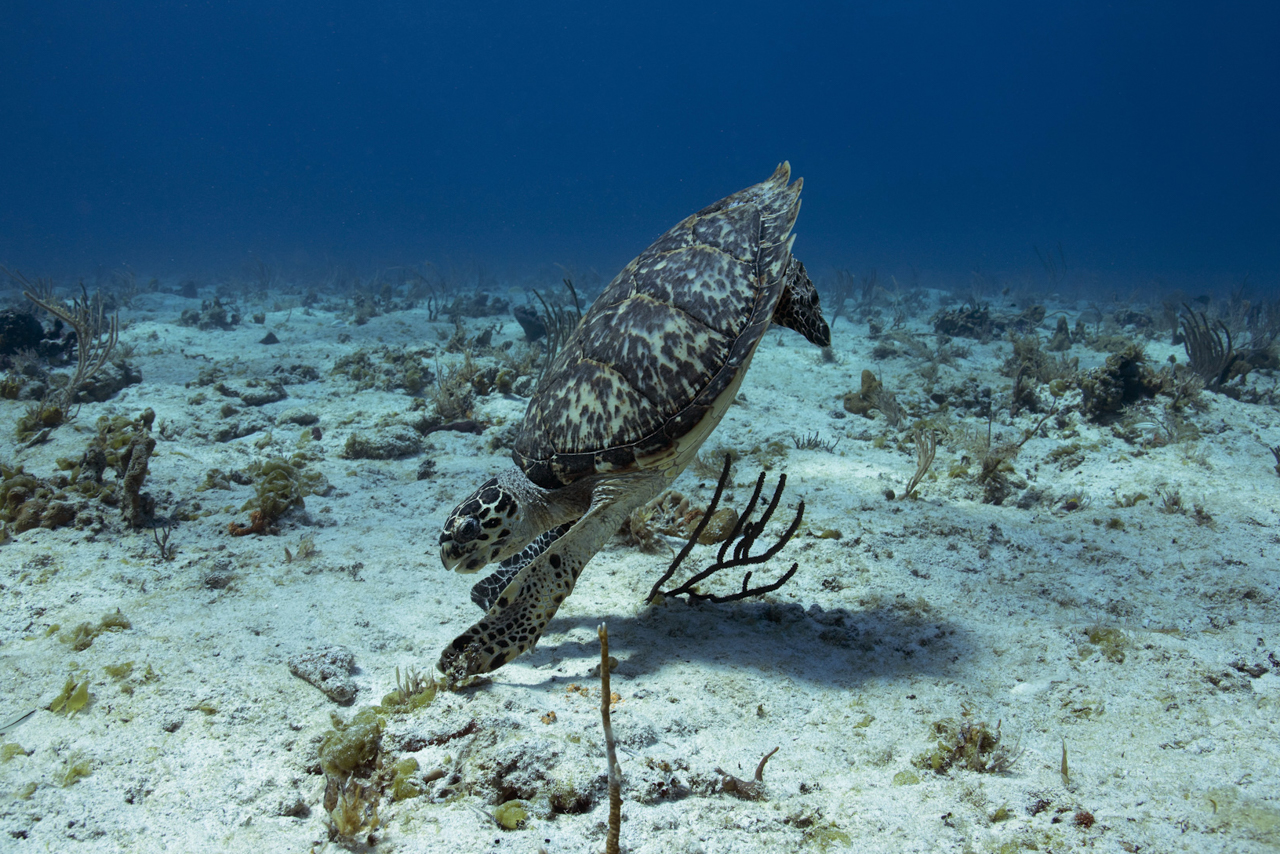
The wonderful little Hawksbill Turtle we found at Highbourne Cay in the Bahamas in April 2018
On a very boring dive I saw her surface for air out of the corner of my eye, approached her and spent over 45 minutes with her. She was beautiful and confident and stayed close the whole dive. It sometimes seemed like she was posing! At one point she placed a flipper in an ideal position and just gazed at me. At the end of our encounter she got into all these crazy positions, as this image shows, while nibbling on the bottom.
I was very sad to leave her. One gets attached, sometimes very attached, to friendly, curious and beautiful animals.
On a very boring dive I saw her surface for air out of the corner of my eye, approached her and spent over 45 minutes with her. She was beautiful and confident and stayed close the whole dive. It sometimes seemed like she was posing! At one point she placed a flipper in an ideal position and just gazed at me. At the end of our encounter she got into all these crazy positions, as this image shows, while nibbling on the bottom.
I was very sad to leave her. One gets attached, sometimes very attached, to friendly, curious and beautiful animals.
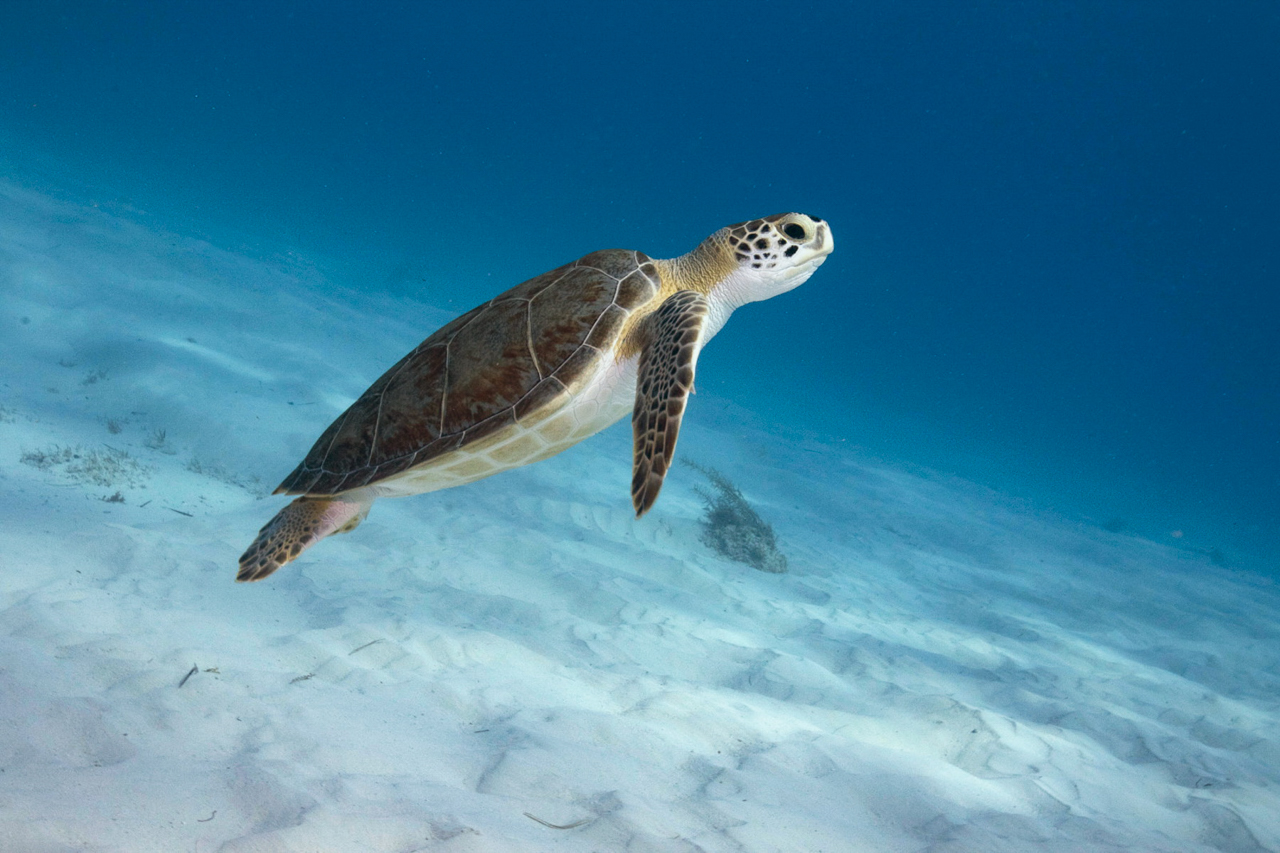
Monique or Matilda – one of the very familiar and tolerant Green Turtles at “The Aquarium” site in the Exumas, April 2018.
Once these turtles let me get close I know I will have an amazing time, revel in how sweet they seem and how familiar they are.
Turtles always seem very wise to me. On average they only live 40-60 years -- Nothing like the century we’re always told about for tortoises on land.
Sometimes I think of them as marine mammals because they can be so interactive and seem so intelligent; but they are, of course, reptiles.
Six out of 7 sea turtle species are endangered – a great tragedy.
Once these turtles let me get close I know I will have an amazing time, revel in how sweet they seem and how familiar they are.
Turtles always seem very wise to me. On average they only live 40-60 years -- Nothing like the century we’re always told about for tortoises on land.
Sometimes I think of them as marine mammals because they can be so interactive and seem so intelligent; but they are, of course, reptiles.
Six out of 7 sea turtle species are endangered – a great tragedy.
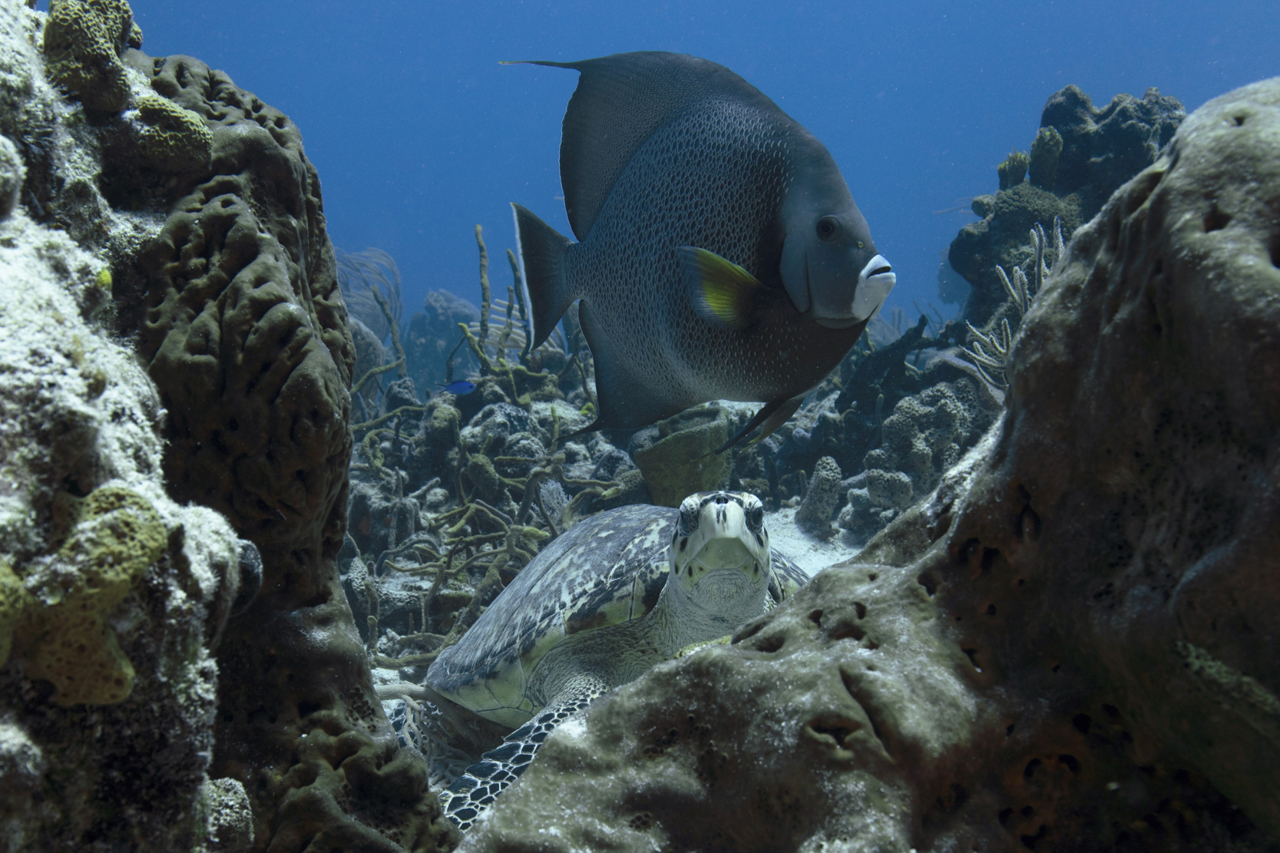
An extremely rare and lucky convergence of a Hawksbill Turtle and a Grey Angelfish photographed in the Exumas in April 2019.
Seeing the turtle I wasn’t yet close to speed up past a large coral head, I didn’t expect to see it again.
But after turning the corner, I saw that not only was it just sitting there but also a beautiful angelfish was with it. Neither seemed particularly concerned when I crept up to photograph them, and they stayed close together for perhaps half a minute, making good photographs easy.
Seeing the turtle I wasn’t yet close to speed up past a large coral head, I didn’t expect to see it again.
But after turning the corner, I saw that not only was it just sitting there but also a beautiful angelfish was with it. Neither seemed particularly concerned when I crept up to photograph them, and they stayed close together for perhaps half a minute, making good photographs easy.
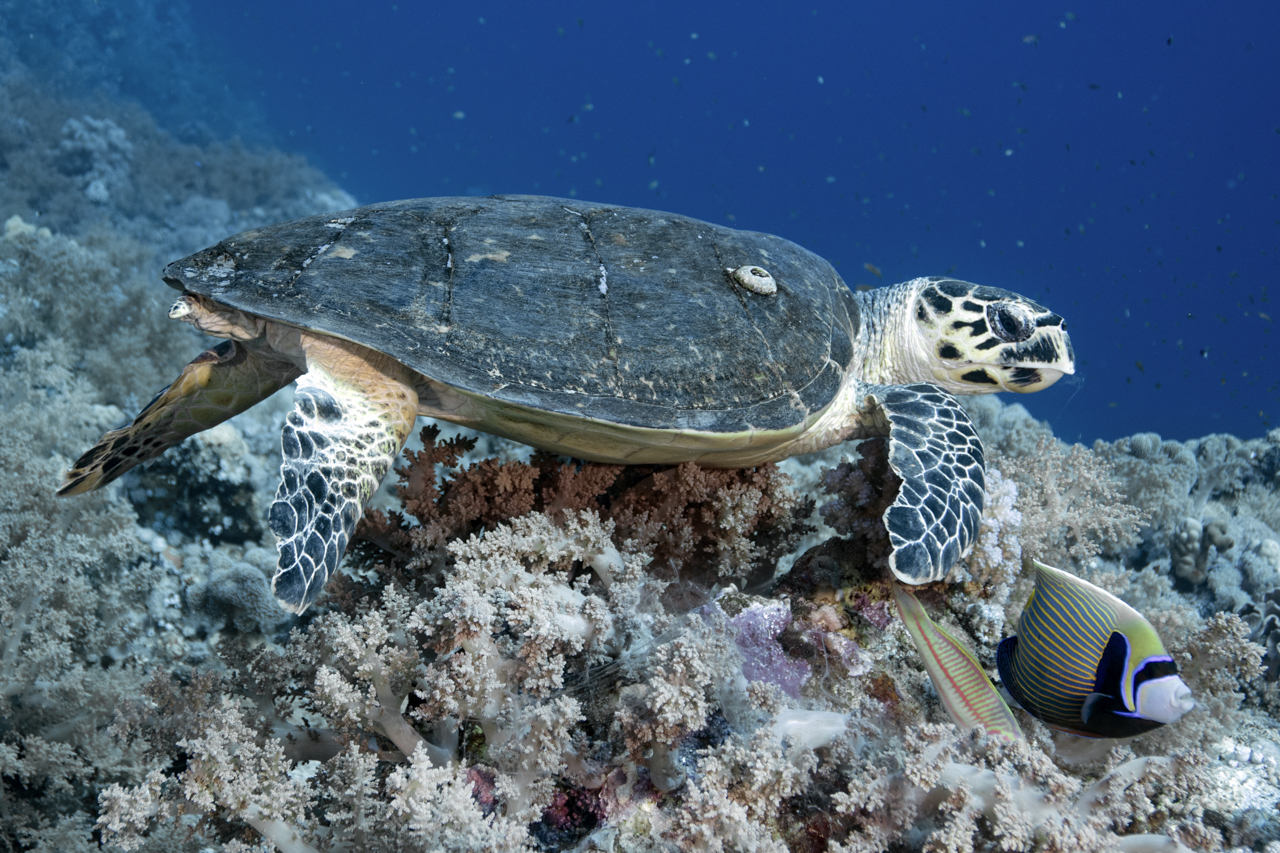
A large Hawksbill Turtle with an Emperor Angelfish and a Klunzinger Wrasse.
Elphinstone, Egypt, November 2019
At the end of the dive I was low on air when I saw this beautiful – and rare -- sight of a duo, and then trio, of animals one doesn’t usually find together, all 3 of them among my favorite species.
Elphinstone, Egypt, November 2019
At the end of the dive I was low on air when I saw this beautiful – and rare -- sight of a duo, and then trio, of animals one doesn’t usually find together, all 3 of them among my favorite species.

The Hawksbill Turtle I found and photographed at Elphinstone in Egypt in November 2019.
After observing its surroundings and lazily swimming above them it decided to eat this soft coral. As the turtle ate, long strands of a gelatinous substance started to form and drift away.
After observing its surroundings and lazily swimming above them it decided to eat this soft coral. As the turtle ate, long strands of a gelatinous substance started to form and drift away.

